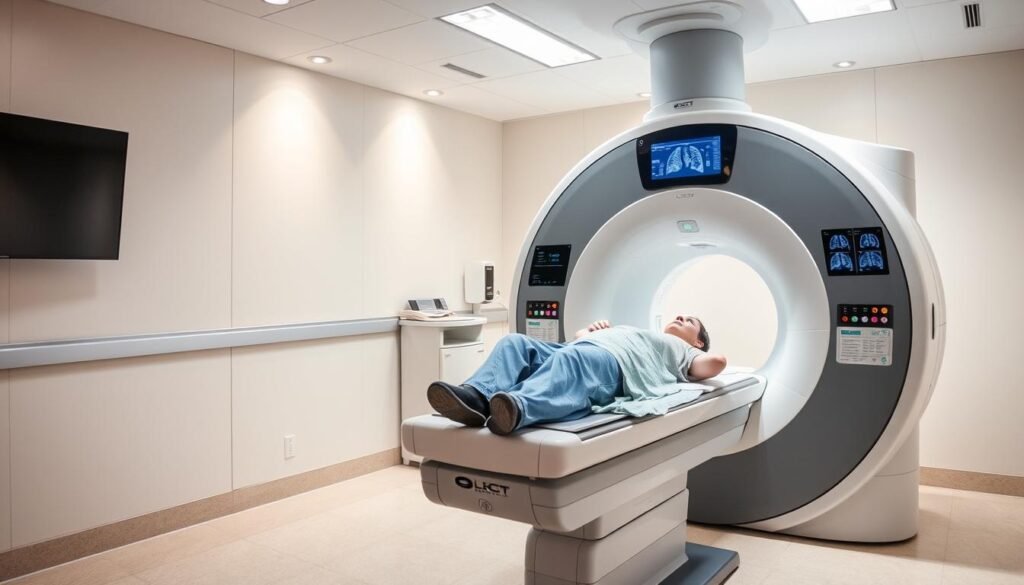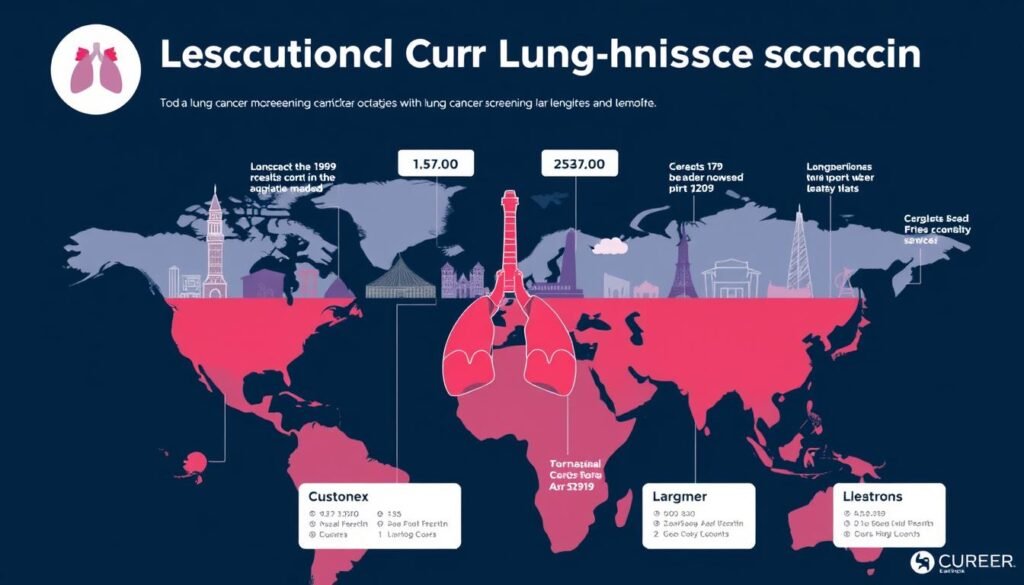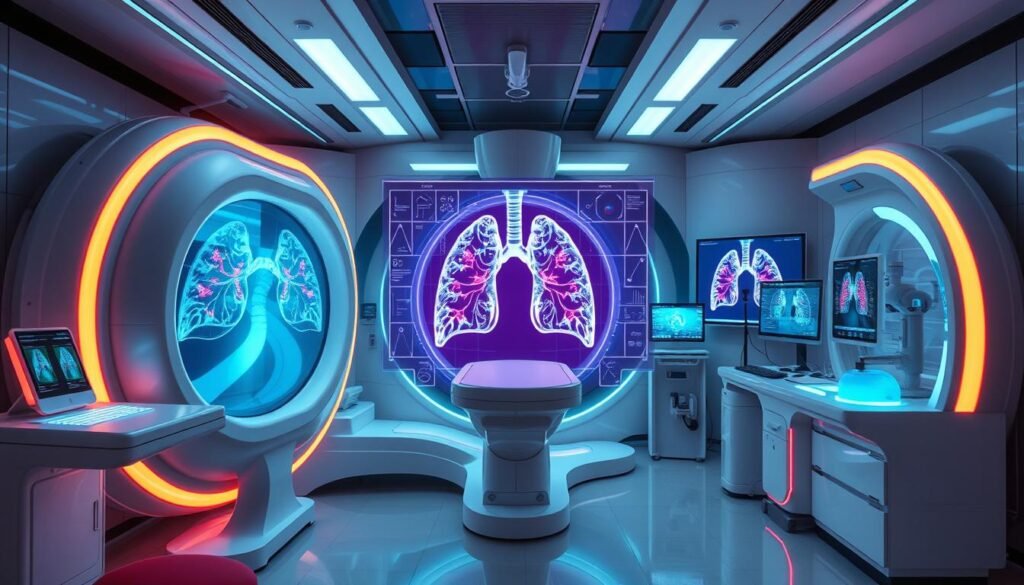The cost to screen current and former smokers aged 50 to 74 each year is huge. It ranges from $126,000 to $169,000 for every quality life year saved. This fact shows how important it is to know about the cost of lung cancer screening today. Screening with low-dose computed tomography (LDCT) can greatly lower death rates from lung cancer. However, the costs can differ a lot. This is due to things like where you are, if you’re eligible, and your insurance.
The cost of lung cancer screening is a big concern for patients and health systems alike. Getting access to trustworthy info is key for making smart choices. Also, the big price differences in lung cancer screening options make things tricky. Knowing about these costs helps high-risk people get the right treatments. It also supports efforts to lessen lung cancer deaths overall.
Key Takeaways
- The cost of lung cancer screening varies significantly based on multiple factors, including participant eligibility.
- LDCT screenings can provide a 20% reduction in lung cancer mortality when accurately utilized.
- Annual screening combined with cessation therapy has demonstrated varying cost-utility ratios.
- Accessibility to affordable lung cancer screening programs is crucial for high-risk individuals.
- Understanding the cost involved is vital for making informed health decisions.
- Differences in expenses across urban and rural settings can significantly impact access to care.
Introduction to Lung Cancer Screening
Lung cancer screening is key in finding the disease early, especially for high-risk people. Lung cancer is the top reason for cancer deaths across the globe. Therefore, knowing about screening is crucial. Each year, lung cancer takes away about 1.8 million lives. This shows how important it is to take early action.
Smoking is a major factor leading to lung cancer. It’s behind many lung cancer cases. Though fewer men are smoking these days, women’s smoking rates are not dropping as fast. Also, about 20% of lung cancer cases happen in non-smokers. This makes it clear that there are other risk factors too. In some parts of Asia, non-smokers make up about 53% of lung cancer cases.
The US Preventive Services Task Force suggests yearly lung cancer checks with LDCT for certain smokers. This includes people who have smoked 20 pack-years or more, those still smoking, or who quit in the last 15 years. They should be between 50 and 80 years old. This method could reduce lung cancer deaths by about 25% in those at high risk.
It’s vital to know about lung cancer screening rules. Aging and serious health problems might affect if a person can get screened. Unfortunately, screening can have downsides. These include false alarms, extra stress and tests, finding cancer that might not cause issues, and exposure to radiation.
As lung cancer screening gets better, knowing about these checks can help those at risk. Getting screened on time can catch the disease early. This makes treatment more likely to work and can boost survival rates for lung cancer patients.
Importance of Lung Cancer Screening
Lung cancer is the top cause of cancer deaths in the U.S. It causes nearly 130,000 deaths each year. Only about 25% of those diagnosed live for five years or more. This is because lung cancer is often found late, when it’s harder to treat. That’s why lung cancer screening is so critical.
People aged 50 to 80 who smoked a lot are advised to get screened every year. A “lot” means at least 20 pack-years of smoking. But sadly, only 6% of those eligible actually get screened. We need more awareness about lung cancer screening. It can play a big role in lowering death rates from this disease.
Studies show that screening with low-dose CT scans lowers lung cancer deaths by over 20%. It finds more than half of cancers early. Early detection means more treatment options. The scan is quick, taking less than a minute. It also uses 80% less radiation than a regular CT scan. This makes it safer for those at risk.
Early detection has many benefits. It gives patients access to better treatments. For example, robotic surgery can mean quicker recovery and less pain. Knowing the value of lung cancer screening can encourage people to take preventive steps. These steps can greatly improve their chances of a better outcome.
Cost of Lung Cancer Screening
The cost of lung cancer screening varies a lot. This is because many factors affect the price. For instance, where you live, the type of place you get screened, and personal details like age and income matter. Additionally, if your insurance covers screening, it can change how much you pay.
What happens after the screening can also impact costs. Patients often need more care, which adds to the expenses. Understanding these costs is important. It helps people know what they might have to pay.
Factors Influencing the Cost
Several key elements contribute to the fluctuation in the costs of lung cancer screening:
- Geographic Location: The cost can change a lot depending on where you live. Some places offer screenings for less money.
- Type of Healthcare Facility: Places linked to academic schools may charge more than local health centers.
- Patient Demographics: Your age and financial situation can affect how much you have to pay.
- Insurance Coverage: Different health plans mean patients might pay different amounts.
- Follow-Up Costs: About 7.4% of patients need another procedure within a year. This affects the total cost.
Average Pricing for Screening Options
Data shows the average cost for lung cancer screening. A study found that 6,268 people with employer insurance paid a total of about $5 million. This means each person paid around $740 on average. Out-of-pocket expenses were about $427,000 in total, or roughly $62 per person. Costs for extra procedures ranged from $0 to $342, with an average of $50.79. People diagnosed with lung cancer during follow-up paid about $332 out of pocket on average.
| Cost Breakdown | Average Cost Per Patient | Out-of-Pocket Cost |
|---|---|---|
| Total Cost of Lung Cancer Screening | $740.06 | $62.46 |
| Follow-Up Procedure Range | $50.79 (median) | $0 – $342.05 |
| Out-of-Pocket for lung cancer diagnosis | $332.24 | – |
Types of Lung Cancer Screening Tests
Lung cancer screenings are key to catching the disease early. There are different types of screenings. This section looks at the main ones, like LDCT and chest X-ray screenings, and others.
Low-Dose Computed Tomography (LDCT)
LDCT is a top method for lung cancer screening. It can greatly increase chances of survival. Detecting lung cancer early with LDCT can boost survival rates by 20 percent.
LDCT scans spot small lung nodules, aiding early treatment. They usually take about 15 minutes. People 50 to 77 years old, especially those who have smoked heavily, should get screened yearly. Insurance often covers it for those 55 to 80.
A study, the National Lung Screening Trial, showed LDCT scans reduced lung cancer death risk by 20 percent, compared to chest X-rays. Experts like radiologists and oncologists create personalized plans for patients with abnormal nodules. This ensures focused care during screening.
Chest X-Ray and Other Alternatives
Chest X-rays are another screening option, but not as effective as LDCT. They can miss smaller nodules. So, LDCT is the preferred method for those at high risk.
Still, chest X-rays can be useful, particularly where advanced imaging isn’t available. There are other tests like sputum cytology and bronchoscopy for checking lung problems. They aren’t mainly for screening. Talk to your doctor about the best screening for you, considering your risk and what’s available.
| Screening Method | Detection Capability | Recommended For | Typical Duration |
|---|---|---|---|
| LDCT | Detects nodules as small as half an inch | High-risk individuals (50-77 years old) | ~15 minutes |
| Chest X-Ray | Detects larger tumors | Limited access scenarios | ~10 minutes |
| Sputum Cytology | Identifies cancer cells in mucus | Follow-up for suspicious findings | Varies |
| Bronchoscopy | Visual inspection of airways | Symptomatic patients | ~30 minutes |

Understanding Insurance Coverage for Screening
The landscape of lung cancer screening insurance coverage is crucial for early detection in high-risk patients. Health insurance plans like Medicare, Medicaid, and private insurers significantly impact the costs of these screenings. It’s important for patients to grasp how insurance affects costs and what is covered.
How Insurance Affects Lung Cancer Screening Costs
Lung cancer screening costs can differ greatly, depending on your health plan. Under the Affordable Care Act, many insurance providers must cover cancer screenings with no out-of-pocket fees, if using in-network facilities. Self-insured plans usually follow similar rules. Even though Medicare may cover the whole cost for those eligible, some may face co-pays. Thus, knowing your insurance benefits and any lung cancer screening subsidies is vital to lower expenses.
Coverage for High-Risk Patients
Insurance coverage for high-risk patients often includes those with a long history of smoking or familial lung cancer history. The US Preventive Services Task Force advises yearly screenings for those 50-80 years old with a 20-pack-year smoking history. This means eligible individuals can get screenings with little to no cost. However, patients should know their insurance coverage criteria, as it varies. Medicaid coverage changes state by state, so checking with local offices is necessary.
Comparing Lung Cancer Screening Expenses Across Locations
Lung cancer screening costs vary greatly by location and healthcare facility type. It’s crucial for individuals to understand these differences when considering their options. We’ll look at how urban versus rural areas and public versus private facilities affect costs.
Urban vs. Rural Pricing Differences
In cities, lung cancer screenings are often pricier than in rural areas. This is due to higher demand and operational costs in urban centers. Cities have access to advanced technology, like low-dose computed tomography (LDCT), affecting the price.
In rural areas, access and availability issues can limit options. This results in less competition and different costs. These urban rural screening price differences impact people’s screening decisions significantly.
Public vs. Private Institutions
The screening facility type is key in cost determination. Public facilities generally have lower prices thanks to government support. This makes screenings more accessible for many people.
Conversely, private facilities often charge more for their advanced technologies and personalized care. This leads to big differences in public private lung cancer screening costs. Understanding these facility type pricing variations helps people make better health and financial decisions.

Finding ways to close the gap in screening access is essential. Recognizing these price differences enables people to find the best screening options for preventing lung cancer.
Research shows a growing need to tackle these challenges. Approaches to increase screening rates in diverse groups are important. Studying costs, like results from the National Lung Screening Trial, aids in addressing and lessening these disparities.
Affordable Lung Cancer Screening Options
Finding affordable ways to check for lung cancer is vital, especially for people who don’t have much. There are local programs that offer these checks at low costs. This helps those who are at high risk to get checked early. These efforts are making sure everyone can get screened, no matter how much money they have.
Community Health Programs
Community health projects are key in making lung cancer tests easier to get. They aim to offer low-cost testing, especially for those who can’t usually afford it. They work with health centers nearby to reach more people. These programs have big pluses like:
- Low-cost or free screenings available without insurance requirements
- Targeted outreach efforts to increase engagement among high-risk populations
- Patient education to raise awareness about the importance of early detection
This makes it possible for communities to find help with the cost of lung cancer checks. It means everyone gets a chance to fight against lung cancer.
Financial Assistance and Grants
For those facing money issues, grants can help with the cost of lung cancer checks. There are groups that offer funds for screening and care afterward. People can find help through:
- Nonprofits focused on cancer awareness and treatment
- Government-funded programs designed to improve health equity
- Local health departments that offer funding for at-risk populations
Looking into these options is crucial for getting the financial aid needed for lung cancer checks. With community help and grants, more people can get screenings that might save their lives.
The Economic Impact of Lung Cancer Screening
The financial side of lung cancer screening shows how finding the disease early saves money. If we catch lung cancer early, treatments can change, which might impact how much we spend on healthcare. Knowing how screening and treatment costs connect is key to using healthcare money wisely.
Cost-Effectiveness Analysis
Looking closely at lung cancer screening tells us it’s worth the cost. For example, screenings that use a high-accuracy biomarker and cost no more than $250 are seen as good for the money. They provide health benefits without too much cost. Yet, when biomarkers cost over $750, it doesn’t make financial sense. This highlights the importance of choosing affordable screening methods.
Long-Term Savings on Treatment Costs
Early detection through screening can cut cancer treatment costs in the long run. Studies like the U.S. National Lung Screening Trial and the NELSON trial have shown a drop in death rates. This means we can catch cancer sooner, which is cheaper to treat. Finding lung cancer early can lessen the cost strain on both patients and insurance companies.
Potential Barriers to Affordable Screening
Several barriers make it tough to get affordable lung cancer screenings. It’s key to address these problems to boost screening rates. That way, people at high risk can get the help they need. The barriers include knowing about programs and facing challenges that discourage getting tested.
Educating both patients and doctors on the importance of screening can help. This education can close the existing gaps.
Awareness and Accessibility Issues
Both patients and doctors don’t know enough about lung cancer screening programs. Though most primary care providers are influenced by the USPSTF, only about half know about the lung cancer screening recommendation. This gap makes accessing lung cancer tests harder, leading to the underuse of key screening options like LDCT. For instance, only 12% of primary care providers in academic settings use LDCT for lung cancer screening.
Socioeconomic Factors Affecting Access
Income, education, and location create big gaps in lung cancer screening access. Only a small part of the U.S. population, aged 55 to 80, is eligible for screening. This highlights the difficulty of reaching enough people. Low-income groups often have lower screening rates due to cost, even when covered by the Affordable Care Act.
Being underinsured and unexpected costs for extra tests make these barriers worse. This makes it harder for low-income people to get screened for lung cancer.
| Barrier Type | Impact |
|---|---|
| Awareness | Limited knowledge among patients leads to fewer screenings. |
| Accessibility | Logistical issues often deter individuals from pursuing tests. |
| Socioeconomic Status | Income and educational disparities affect screening uptake. |
| Insurance Coverage | Cost-related barriers impact access, even with ACA provisions. |
Future Considerations for Lung Cancer Screening
Lung cancer screening is looking up because of big leaps in technology and health policy changes. There is a push to make screening better and within reach for everyone. Things like better imaging and smart technology could soon spot lung cancer early. This could help more people beat the disease.
Advancements in Screening Technologies
Soon, finding lung cancer will be transformed by new technologies. We might see:
- Enhanced imaging modalities that offer clearer, more accurate results.
- Machine learning algorithms to analyze imaging data efficiently.
- Biomarkers for identifying high-risk patients and improving screening accuracy.
Research shows that low-dose computed tomography (LDCT) cuts lung cancer deaths by 20%. It’s great at finding cancer early. As health care changes, these breakthroughs will set new standards for treating lung cancer.
Policy Changes Impacting Screening Costs
Policies are key in shaping how we screen for lung cancer. Lately, policies have focused on making screening more affordable by covering costs. Also, putting money into LDCT programs highlights the push for early screening. Policy changes can really impact who gets screened and how often.
Right now, very few people who should get screened actually do, just 1.9%. We need better policies to fix this gap and get more people screened. By matching tech advances with good policies, lung cancer screening’s future is bright.

| Technology | Benefit | Current Status |
|---|---|---|
| Low-Dose Computed Tomography (LDCT) | 20% reduction in mortality | Widely implemented |
| Artificial Intelligence | Improved accuracy in imaging | In development |
| Biomarker Testing | Risk stratification | Research phase |
Conclusion
The cost analysis of lung cancer screening shows its value and benefit. Annual screenings using low-dose computed tomography (LDCT) reduce lung cancer deaths by 20% compared to chest X-rays. This clearly supports the need for routine screenings for those at high risk.
The lung cancer screening project costs $27.8 billion over 15 years. Yet, it saves lives at a cost of $28,240 per quality-adjusted life year (QALY) gained. This proves lung cancer screenings are crucial for better health outcomes. However, it’s worrying that only 16% of those eligible actually get screened.
Including smoking cessation programs can make screenings more cost-effective and successful. Healthcare providers must make informed choices easier and improve access to screenings. This will help save more lives and increase the acceptance of lung cancer screenings. For a closer look at how PET scans help in early detection and treatment, click on this resource.